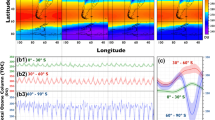Abstract
We have developed quadratic regression models that predict the daily ozone concentration in either the Uintah Basin (UB) of Utah, USA, or the Upper Green River Basin (UGRB) of Wyoming, USA. Sites selected for study are ozone stations near the towns of Ouray, Utah, in the UB and Boulder, Wyoming, in the UGRB. Input data for the UB model are daily values of lapse rate, snow depth, solar angle, temperature, and the number of consecutive days under inversion conditions. The UGRB model also requires the wind speed. Standard errors are 10 and 5 ppb for the UB and the UGRB, respectively. The models have been optimized to predict seasonal exceedances of the National Ambient Air Quality Standard (NAAQS), i.e., the number of times each season that the daily maximum in the eight-hour running average exceeds 75 ppb, and they perform in this regard to an accuracy of ±1 day. (However, Ouray is not at this time a regulatory site for judging compliance with federal law.) We predict that any given winter will be NAAQS compliant with 44 % odds in the UB and with 60 % odds in the UGRB. We have estimated the ozone production for each winter in the UB since 1950, under the assumption that precursor emissions are at modern values.











Similar content being viewed by others
References
EPA (2012) Air data. United States Environmental Protection Agency. www.epa.gov/airdata/ad_maps.html
Finlayson-Pitts BJ, Pitts JN (2000) Chemistry of the upper and lower atmosphere. Academic, San Diego
Mansfield M, Hall C (2013) The potential for ozone production in the Uintah Basin: a climatological analysis. In: Lyman S, Shorthill H (eds) Final report: 2012 Uintah Basin Winter Ozone and Air Quality Study. Utah State University, document no. CRD13-320.32, February 1, 2013. rd.usu.edu/files/uploads/ubos_2011-12_final_report.pdf
Martin R, Moore K, Mansfield M, Hill S, Harper K, Shorthill (2011) Final report: Uinta Basin Winter Ozone and Air Quality Study: December 2010–March 2011. Energy Dynamics Laboratory, Utah State University Research Foundation, document no. EDL/11-039, June 14, 2011. rd.usu.edu/files/uploads/edl_2010-11_report_ozone_final.pdf
McVehil-Monnett Associates, Inc. (2011) Ground-level ozone and meteorological parameter correlation analysis for the upper Green River Basin. Report to Wyoming Department of Environmental Quality, October 2011, MMA project no. 2451-11. www.mcvehil-monnett.com
NOAA:NCDC (2012) National Climatic Data Center, National Oceanic and Atmospheric Administration. www.ncdc.noaa.gov/land-based-station-data/land-based-datasets
Schnell RC, Oltmans SJ, Neeley RR, Endres MS, Molenar JV, White AB (2009) Rapid photochemical production at high concentrations in a rural site during winter. Nat Geosci 2:120–122
Seinfeld JH, Pandis SN (2006) Atmospheric chemistry and physics, 2nd edn. Wiley-Interscience, Hoboken
Stoeckenius T, Ma L (2010) Final report: a conceptual model of winter ozone episodes in Southwest Wyoming, Environ, Novato
Utah Climate Center (2012) Utah Climate Center, Utah State University. www.climate.usurf.usu.edu
Acknowledgments
This research was funded by the Uintah Impact Mitigation Special Services District, Uintah County, Utah, USA, and by the Utah Science Technology and Research Initiative.
Author information
Authors and Affiliations
Corresponding author
Electronic Supplementary Material
Below is the link to the electronic supplementary material.
Online Resource 1
Lists and maps of meteorological stations. Also includes a statement on selection criteria for the meteorological stations representing each basin. (DOCX 23 kb)
Online Resource 2
Regression coefficients of each of the models. (DOCX 33 kb)
Online Resource 3
Figures showing quality of fit, i.e., predicted vs. measured concentrations, for each of the models. (DOCX 738 kb)
Online Resource 4
Data in support of the decision to use Ouray-5 and Boulder-6 as representative models. (DOCX 23 kb)
Rights and permissions
About this article
Cite this article
Mansfield, M.L., Hall, C.F. Statistical analysis of winter ozone events. Air Qual Atmos Health 6, 687–699 (2013). https://doi.org/10.1007/s11869-013-0204-0
Received:
Accepted:
Published:
Issue Date:
DOI: https://doi.org/10.1007/s11869-013-0204-0




